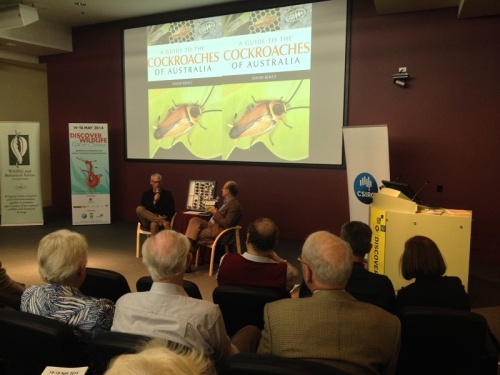COCKROACHES, if the director of the CSIRO Discovery Centre Cris Kennedy is to be heeded, have long suffered from an undeservedly bad reputation.
Small matter that they have inspired seminal works of world literature and theatre, these ancient creatures have been sorely neglected by visual artists.
But that may all be about to change, with the launch today of “Discover Wildlife: Art and Science,” a new exhibition and symposium for artists, science and conservationists, opening today at the centre and running until May 18.
The program, which includes opportunities for both artists and scientists to view the CSIRO collections, was opened in fine style with a Q&A between Kennedy and American entomologist Dr David Rentz, whose new taxonomic book, “a guide to the cockroaches of Australia,” co-produced with Helen Cameron, looks set to throw the spotlight on at least the 550 species of cockroach that have been described so far.
In a wide-ranging and entertaining discussion in which Rentz placed the subject in the context of diminishing support for science everywhere, he proposed the idea that especially in rainforest locations in Australia, the cockroach served a positive ecological function, though he had to admit that when they turn up in your kitchen it’s a good idea to control them.
Kennedy couldn’t resist pointing out to us that in 2011 Rentz had been cowinner of an ‘Ig Nobel Prize’ at Harvard University for a paper, “Beetles on the Bottle: Male Buprestids Mistake Stubbies for Females.”
Julia Landford, president of the Canberra-based Wildlife and Botanical Artists Association, WABA, had earlier joined Kennedy to highlight some of the events taking place this week that it would appeal to specialists, generalists, artists and families.
Asked by Kennedy to nominate two highlights, she named sessions with filmmaker Jeff Dorin, who has, documented previously unseen rock art with Kimberley elders and Melbourne wildlife artist-zoologist Peter Trusler, best known for illustrations on Australian postage stamps, who, as well as working as an illustrator, has continued his scientific interest in interpreting fossil records.
Landford also explained that the exhibition, which runs to March 31, involved 70 artists who had submitted work around Australia. While it was not possible to hang all of those works, all the be accessible on video screens.
Kennedy alerted those present to Landford’s own artwork, a watercolour work telling the story of endangered moths specific to the ACT and northern Victoria.
But the symposium will stretch further, with a look at plans to set up the first wildlife art museum in the Grampians, meet the makers art sessions, collection tours focusing on insects and wildlife, a presentation of the CSIRO “Synapse” project in science art and technology, photography workshops with the Australian wildlife photographer Steve Parish, and as part of a family day, a free public lecture for children by Parish on how to tell a story with your camera.
Gala highlight of the week will be the Friday night fundraising dinner at University House with the ecologist David Lindenmayer speaking. But you’ll have to be quick to get into that.
“Discover Wildlife: Art and Science,” at CSIRO Discovery Centre, May 14-18, events are both free and ticketed, for all program details and how to book, visit info.discovery@csiro.au or waba.net.au
The post Wildlife science and art under the spotlight appeared first on Canberra CityNews.
